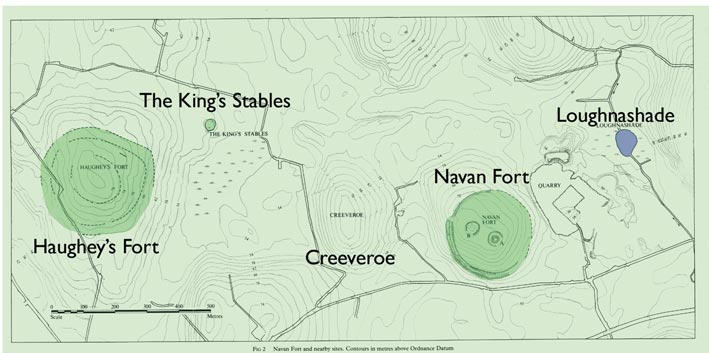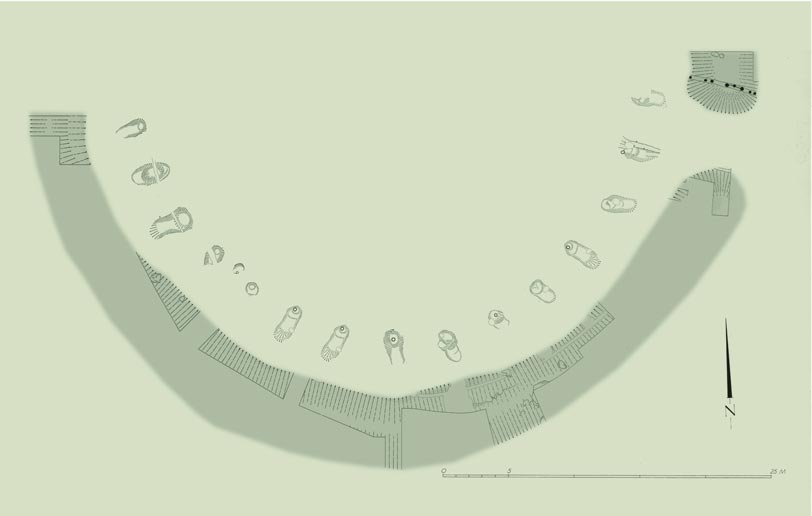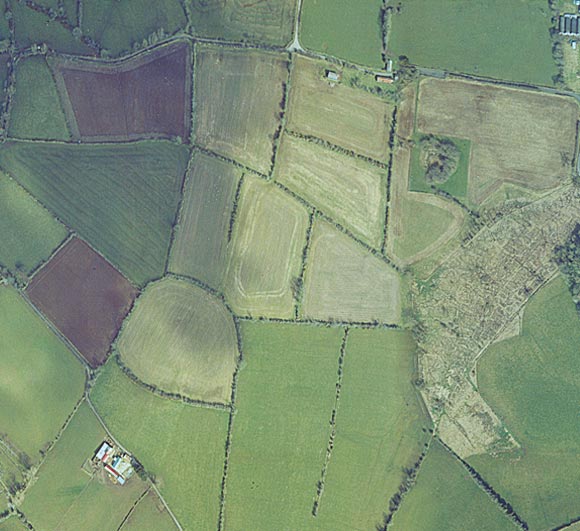Late Bronze Age Ireland 1200 – 300 BC
The number of bronze and gold ornaments and the hundreds of bronze spears and swords discovered from the Late Bronze Age suggest that society had become aristocratic and warlike. Burial patterns changed to be replaced by some unknown ritual. The few burials that have been discovered consist of cremations placed in a mound surrounded by a ring ditch. The increase in the number of Late Bronze Age hoards discovered suggests that a person’s wealth was publicly offered rather than buried with them. The majority of hoards are found in wetland areas suggesting the ritual of depositing precious objects in bodies of water.
There is little evidence of settlement from this period apart from hillforts which suggest political instability and the development of larger societies.
Navan Fort Complex in the Late Bronze Age
The evidence of Late Bronze Age occupation in Co.Armagh is limited to the Navan complex which includes settlement at Navan Fort and Haughey’s Fort, the King’s Stables ritual pool and the linear earthworks at Creeveroe.

Navan Fort in the Late Bronze Age: plan of the Navan fort Complex [copyright NIEA]
Navan Fort in the Late Bronze Age
The expansion of arable agriculture continued around the Navan Fort area with minor periods of forest regeneration. The Late Bronze Age/ Early Iron Age c. 600-100 BC saw an expansion of the creation and use of grassland for grazing cattle. Towards the end of the Late Bronze Age, the water level in Loughnashade began to rise suggesting an increase in rain fall and perhaps a general deterioration in the climate.
Navan Fort Site B – Late Bronze Age Ring Ditch and Post Structures

Navan Fort in the Late Bronze Age: Site B ditch and posts [copyright NIEA]
Late Bronze Age settlement- Haughey’s fort

Navan Fort in the Late Bronze Age: Haughey’s Fort
Haughey’s Fort lies to the west of Navan Fort and is thought to have been occupied by a community, which included aristocratic members, in the early part of the Late Bronze Age. The settlement consisted of a hillfort, 320 m diameter, surrounded by three concentric ditches. These ditches were 2.8m deep and 3m wide and originally excavated around 1100 – 1000BC. Evidence of post and stake holes suggest an internal stockade that would have enclosed an area of approximately 140m diameter. The larger inner ditch contained a series of concentric arcs of pits of various sizes which produced Late Bronze Age pottery (flat-rimmed-ware), tiny fragments of gold ornaments, seeds, and animal bones. The seeds suggest that local cereal production was dominated by barley. The bones were from a mixture of domesticated breeds; cattle, sheep, pigs, dogs and wild animals; foxes and deer. The skulls of some of the domesticated animals were unusually large; two of the dog skulls discovered are the largest from any prehistoric site. The discovery of a cup and ring marked stone suggest the site had a religious element. Similar finds have been discovered along the Atlantic coast and are thought to be mandala-like symbols (representing the universe), dating from Neolithic or Early Bronze Age. The stone may have been removed from elsewhere and reburied as a offering. Occupation of the Haughey’s Fort site coincides with the creation of the votive pool at the King’s Stables and there is evidence of an entrance aligned with the ritual site.
Late Bronze Age Ritual Pool: The King’s Stables

Navan Fort in the Late Bronze Age: The King’s Stables [copyright NIEA]
Late Bronze Age Earthwork: Creeveroe
Several stretches of double-ditch earthworks have been discovered running North to South in the townlands of Tray, Creeveroe and Tirearly. If the ditches were continuous they would form an earthwork 1.7km long, dividing the land between Haughey’s Fort and Navan Fort. The linear v-shaped ditches, 7.2 m apart, at Creeveroe contained animal-bones and flat-rimmed-ware that date the construction to the Late Bronze Age.
